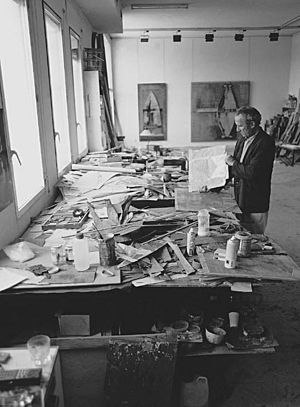Lucio Muñoz facts for kids
Quick facts for kids
Lucio Muñoz
|
|
|---|---|

Lucio Muñoz in his studio, 1990s
|
|
| Born | 27 December 1929 |
| Died | 24 May 1998 (aged 68) |
| Nationality | Spanish |
| Education | Real Academia de Bellas Artes de San Fernando |
| Known for | Abstract painting |
| Movement | Art informel |
| Awards | Neblí Award for Painting Gold medal, Salzburg Biennial of Sacred Art National Award for the Plastic Arts Spanish Association of Art Critics |
Lucio Muñoz (born December 27, 1929 – died May 24, 1998) was a famous Spanish artist. He was known for his unique abstract paintings and engravings. Abstract art doesn't show real-life things exactly. Instead, it uses shapes, colors, and textures to express feelings or ideas. Lucio Muñoz was very creative with materials like wood and burnt paper in his artworks.
Contents
Early Life and Education
Lucio Muñoz was born in Madrid, Spain, on December 27, 1929. He was the youngest of five children. His father was a shopkeeper.
In 1949, Lucio began studying art. He went to the Royal Academy of Fine Arts in San Fernando. There, he earned a degree in Fine Arts. While at the school, he met Amalia Avia. They got married in 1960 and had four children together.
His Artistic Style
Lucio Muñoz had his first art show in Madrid in 1955. This was a big step for him as an artist.
Influence of Art Informel
From 1955 to 1956, Lucio traveled to Paris, France. This trip was paid for by a Spanish government scholarship. In Paris, he was greatly influenced by a style called Art Informel. This art movement focused on using materials and textures in new ways. Artists often worked with non-traditional items.
Working with Materials
Lucio Muñoz started to experiment with different materials. He used burnt paper and wood in his art, not just canvas. He would also pierce, bend, and cut the canvas. This was a common technique for artists in the Art Informel movement.
He became especially known for his works on wood. He made the wood a full part of the artwork itself. He used techniques like burning, carving, and mixing paint with other materials. These materials included marble dust, sawdust, and crushed minerals. He called these special artworks pseudo-paintings.
Colors and Evolution
Lucio Muñoz often used dark colors in his art, especially black. Later in his career, his style became less harsh. He started using different materials that gave his art a softer look.
In 1964, a new art gallery opened in Madrid called Galería Juana Mordó. Lucio Muñoz was part of the group of artists connected to this gallery. He stayed with them until 1991.
Notable Works and Awards
Lucio Muñoz created many important artworks. Some of his most famous pieces are large murals.
- He painted murals for the European Union building in Brussels.
- He also created a mural for the chamber of the Madrid Parliament.
- His mural at the Basilica of Aránzazu won a special award. It received the Gold Medal at the Salzburg Biennial of Sacred Art.
Lucio Muñoz received several other awards for his art during his lifetime. These included the Neblí Award for Painting and the National Award for the Plastic Arts.
See also
 In Spanish: Lucio Muñoz para niños
In Spanish: Lucio Muñoz para niños

